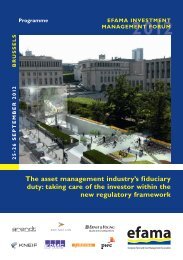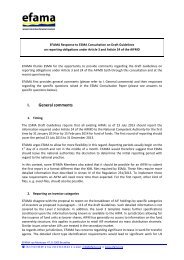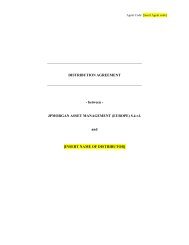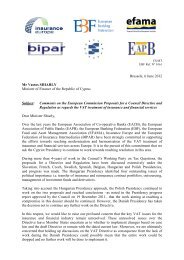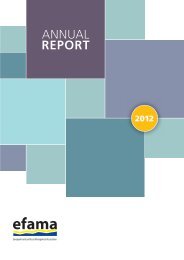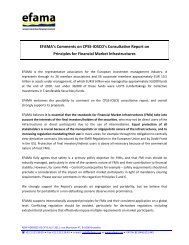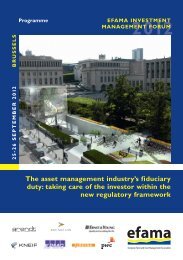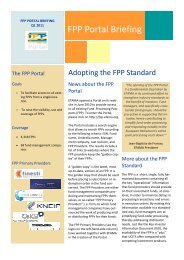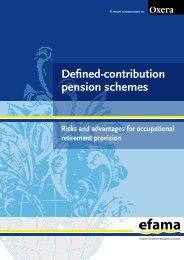EFAMA KPMG Solvency II Report
EFAMA KPMG Solvency II Report
EFAMA KPMG Solvency II Report
Create successful ePaper yourself
Turn your PDF publications into a flip-book with our unique Google optimized e-Paper software.
Figure 4.1.1.a – Types of data required for <strong>Solvency</strong> <strong>II</strong><br />
Internal External Types<br />
of data<br />
✓ ✓ Instrument<br />
✓ ✓ Geographic<br />
✗ ✓ Classifi cations<br />
✓ ✓ Income<br />
✓ ✗ Fund data<br />
✓ ✗ Trades<br />
✓ ✓ Valuation<br />
✓ ✗ OTC Deriv<br />
✓ ✓ Risk<br />
✓ ✓ Structured<br />
✗ ✓ Issuer<br />
✗ ✓ Credit Ratings<br />
✓ ✓ Collateral<br />
✓ ✗ Sec lending<br />
Accounting<br />
and Valuation<br />
Derivatives<br />
Data<br />
Vendors<br />
Custody<br />
4 WORKING GROUP FINDINGS | 17<br />
Primary Extra Business process/ Client<br />
data source QA Data Management System facing<br />
Post-trade<br />
Compliance<br />
Collateral<br />
Stock Lending<br />
Data<br />
Vendors<br />
Maintain all<br />
relevant data<br />
Additional<br />
vended data<br />
Daily data quality<br />
maintenance<br />
Historical data<br />
retention<br />
Client<br />
reporting<br />
Source: HSBC Security Services<br />
Chris Johnson, chris.johnson@hsbc.com<br />
Note: These measures represent a subjective industry interpretation. The ratings do not represent HSBC’s business.<br />
The diversity of the data elements required for Pillar 3 reporting alone means<br />
that the source will not be limited to one application or storage system within<br />
the asset servicing providers. The major proportion will most likely come from<br />
an accounting system, with some enrichment or transformation, but there is also<br />
a significant amount of data required for the asset QRTs that will need to come<br />
from other sources.<br />
Figure 4.1.1.b shows a potential source analysis for a representative insurer.<br />
The distinction made between a standard and ‘enhanced’ source is that the<br />
data elements referred as ‘enhanced’ require some form of enrichment or<br />
transformation, for example automation of the Complementary Identifi cation<br />
Code (CIC) being based upon an asset’s characteristic.<br />
© 2012 <strong>KPMG</strong> LLP, a UK limited liability partnership, is a subsidiary of <strong>KPMG</strong> Europe LLP and a member fi rm of the <strong>KPMG</strong> network of independent member fi rms affi liated with <strong>KPMG</strong> International<br />
Cooperative, a Swiss entity. All rights reserved.<br />
Client 1<br />
Client 2<br />
Client 3<br />
Client 4<br />
Client 5




